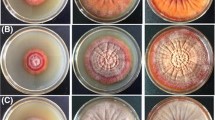Summary
Polysaccharides like dextrine and starch are shown to be the best carbon sources for the growth ofAureobasidium pullulans although growth is good upon a variety of other carbon sources. Light increases growth markedly when polysaccharides are the carbon source but not when other sugars are used. Variation in cell morphology is described in response to sugars and light. Extracellular granules, whose properties resemble those of melanin, are produced when dextrine is the carbon source in a defined medium containing asparagine as the source of nitrogen. The dark pigment was extracted from the walls of thick-walled brown cells ofA. pullulans and characterized as a melanin on the basis of several tests, including solubility and absorption spectrum.A. pullulans was grown on several defined and undefined media and the response of the fungus to light is shown to be determined by the medium, and the temperature at which the cultures are grown.
Similar content being viewed by others
References
Barnett, H. L. (1960). Illustrated genera of imperfect fungi. Minneapolis, U.S.A: Burgess Publishing Co.
Bauer, R. (1938). Beiträge zur Physiologie vonDematium pullulans de Bary. Zbl. Bakt. II,98, 133–167.
Ciferri, R., Ribaldi, M. &Corte, A. (1957). Revision of 23 strains ofAureobasidium pullulans (de By.)Arn. (=Pullularia pullulans). Atti Ist. Bot. Univ. Pavia, Lab. Critt.14, 78–90.
Clark, D. S. &Wallace, R. H. (1958). Carbohydrate metabolism ofPullularia pullulans. Canad. J. Microbiol.4, 44–54.
Cooke, W. B. (1962). An ecological life-history ofAureobasidium pullulans. Unpublished manuscript.
Fraser, L. (1933). An investigation of the sooty moulds of New South Wales. Proc. Linn. Soc., N.S. Wales,58, 375–395.
Gilman, J. C. (1957). A manual of soil fungi. 2nd Ed. Ames, U.S.A.: Iowa State College Press.
Koch, L. H. &McMeekin, T. L. (1924). A new direct nesslerization microkjeldahl method and a modification of the Nessler-Folin reagent for ammonia. J. Amer. chem. Soc.46, 2066–2068.
Luteraan, P. J. (1954a). Influence de la forme ensemencée sur le développement et le comportement métabolique dePullularia pullulans (de Bary etLöw)Berkhout en présence de nitrate de sodium, C. R. Acad. Sci. (Paris),239, 595–597.
Luteraan, P. J. (1954b). De quelques relations entre des modifications morphologiques et des changements métaboliques obtenus chez des champignons par la restriction en azote d'un milieu de culture plus ou moins aéré. C. R. Acad. Sci. (Paris),239, 1046–1048.
Negroni, P. &Fischer, I. (1942). Estudio micológico de treinta cepas dePullularia (Dematium)pullulans. Rev. Inst. Bact. „Dr. Carlos C. Malbran“,11, 99–108.
Nickerson, W. J., Tabor, W. A. &Falcone, G. (1956). Physiological bases of morphogenesis in fungi. V. Effect of selenite and tellurite on cellular division of yeast-like fungi. Canad. J. Microbiol.2, 575–585.
Nossal, P. M. (1953). A mechanical cell disintegrator. Austr. J. exp. Biol. Med. Sci.31, 583–590.
Pearse, E. A. G. (1961). Histochemistry, theoretical and applied. Boston, U.S.A.: Little, Brown & Co.
Roukhelman, Nadia. (1937). Sur un champignon nouveau à pigment noir appartenant au genreTorula. C. R. Soc. Biol. (Paris),124, 545–547.
Ryan, F. T. (1950). Selected methods ofNeurospora genetics. In Methods in Medical Research, ed. Gerard, R.3, 51–75. Chicago, U.S.A.: Year Book Publishers, Inc.
Schaeffer, P. (1953). A black mutant ofNeurospora crassa. Mode of action of the mutant allele and action of light. Arch. Biochem. Biophys.47, 359–375.
Steinhaus, E. A. (1955). Observations on the symbiotes of certain coccidae. Hilgardia,24, 185–206.
White, L. P. (1958). Melanin, a naturally occurring cation exchange material. Nature (Lond.),182, 1427–1428.
Wynne, E. S. &Gott, C. L. (1956). A proposed revision of the genusPullularia. J. gen. Microbiol.14, 512–519.
Author information
Authors and Affiliations
Rights and permissions
About this article
Cite this article
Lingappa, Y., Sussman, A.S. & Bernstein, I.A. Effect of light and media upon growth and melanin formation in aureobasidium pullulans (de By.)Arn. (=pullularia pullulans). Mycopathologia et Mycologia Applicata 20, 109–128 (1963). https://doi.org/10.1007/BF02054883
Issue Date:
DOI: https://doi.org/10.1007/BF02054883




